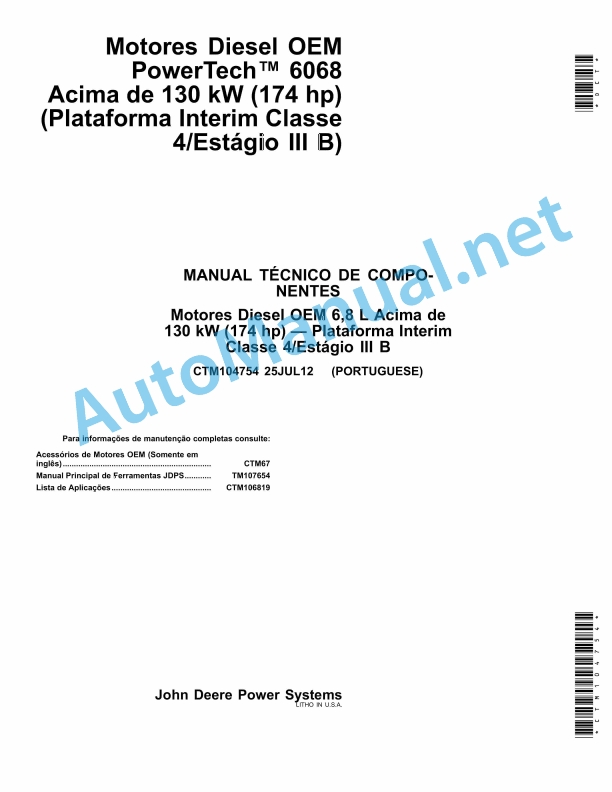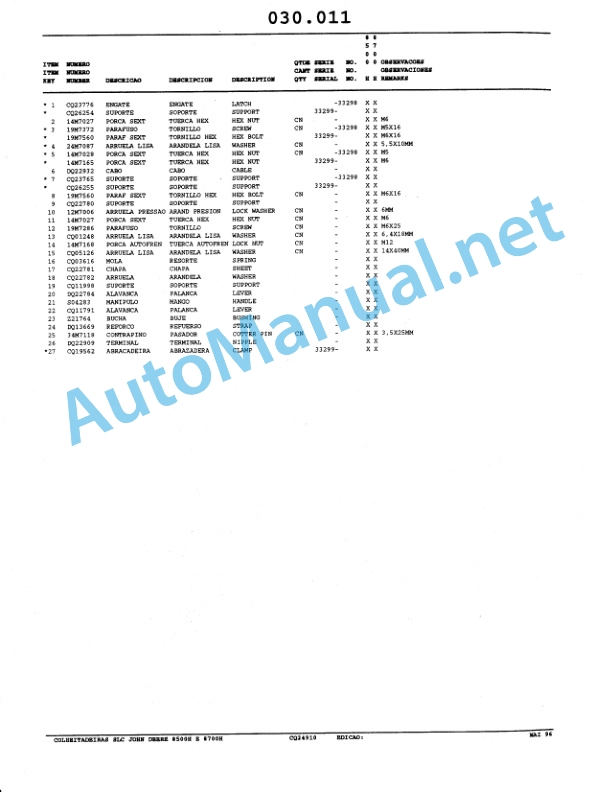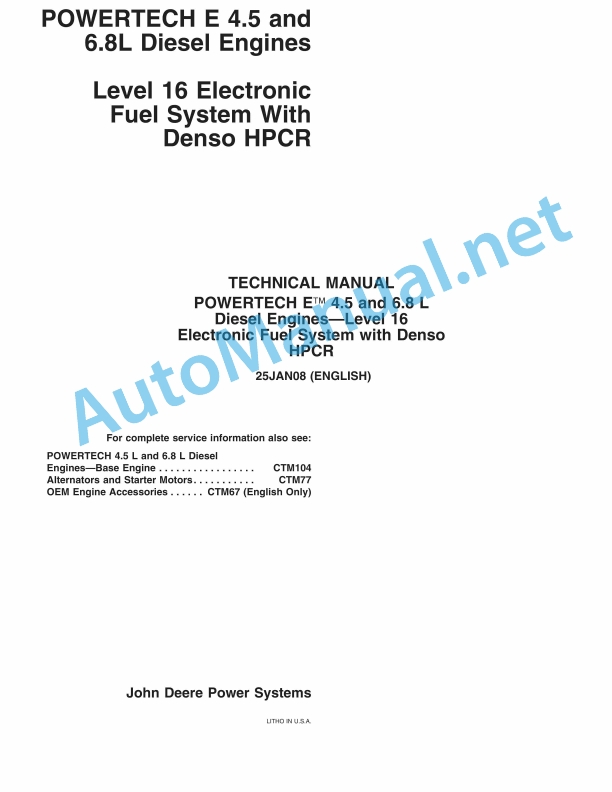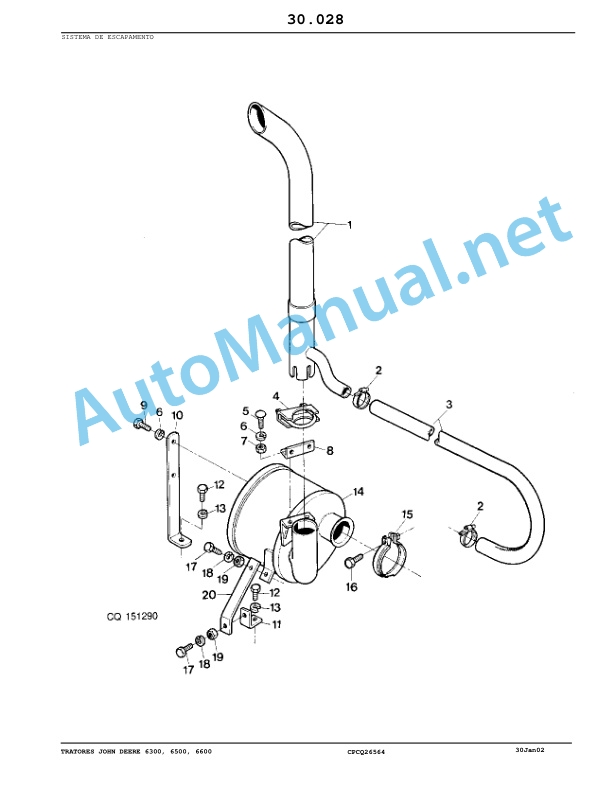Claas Volto 77 (231) Tedders Operator Manual ES
$50.00
- Model: Volto 77 (231) Tedders
- Type Of Manual: Operator Manual
- Language: ES
- Format: PDF(s)
- Size: 24.1 MB
File List:
00 2308 726 2.pdf
00 2308 726 2.pdf:
VOLTO 80VOLTO 60
1. Introduction
1.1 Information regarding the instruction manual
1.1.1 Validity of the manual
1.1.2 Information relating to this instruction manual
1.1.3 Symbols and indications
1.1.4 Optional equipment
1.1.5 Qualified specialized workshop
1.1.6 Information regarding warranty
1.1.7 Spare parts and technical issues
1.2 Proper application of the machine
1.2.1 Proper machine application
1.2.2 Logically foreseeable inappropriate application
2 Security
2.1 Recognize warning signs
2.1.1 Danger symbols
2.1.2 Keyword
2.2 Safety instructions
2.2.1 Meaning of the instruction manual
2.2.2 Observe graphic danger symbols and alarm indications
2.2.3 Requirements for all people working with the machine
2.2.4 Children in danger
2.2.5 Danger zones
2.2.6 Position yourself between the tractor and the machine
2.2.7 Accompanying persons
2.2.8 Couple the tractor with the machine
2.2.9 Risk of injury due to rotating shafts
2.2.10 Construction changes
2.2.11 Optional equipment and spare parts
2.2.12 Control of the machine in operation
2.2.13 Use only after correct start-up
2.2.14 Technical status
2.2.15 Danger due to machine breakdowns
2.2.16 Comply with technical limit values
2.2.17 Danger due to coasting parts
2.2.18 Keep protective devices operational
2.2.19 Personal protective equipment
2.2.20 Wear appropriate clothing
2.2.21 Remove dirt and loose objects
2.2.22 Prepare the machine for road traffic
2.2.23 Dangers when driving on the road and in the countryside
2.2.24 Park the machine safely
2.2.25 Parking without supervision
2.2.26 Unsuitable consumables
2.2.27 Safe handling of consumables and auxiliary materials
2.2.28 Environmental protection and waste disposal
2.2.29 Fire protection
2.2.30 Deadly electrical discharge through overhead lines
2.2.31 Liquids under pressure
2.2.32 Hot surfaces
2.2.33 Work only on the stopped machine
2.2.34 Maintenance work and repair work
2.2.35 Machine parts and lifted loads
2.2.36 Danger from welding work
2.3 Safety instructions on the machine
2.3.1 Structure of graphic hazard symbols
2.3.2 Position of warning symbols on the machine
3 Machine Description
3.1 Summary and operation
3.1.1 Summary of the VOLTO 80
3.1.2 VOLTO 80 operating mode
3.1.3 Summary of the VOLTO 60
3.1.4 VOLTO 60 operating mode
3.2 Optional equipment
3.2.1 Union fork kit*
3.2.2 Hydraulic connection parts 1 piece*
3.2.3 Hydraulic connection parts 2 pieces*
3.2.4 Anti-loss safety for tines ø 9.5 mm*
3.2.5 Mechanical limiting canvas*
3.2.6 Hydraulic limiting canvas*
3.2.7 Elevation at the headboards*
3.2.8 Feeler wheel*
3.2.9 Spare wheel 16×6.5-8*
3.2.10 Gear for making rows at night*
3.3 Identification plates and vehicle identification number
3.31Machine identification plate
3.4 Machine information
3.4.1 Adhesive on the machine
4 Control and display instruments
4.1 Control elements
4.1.1 Hydraulic hose
4.1.2 Pull rope for lifting headlands*
4.1.3 Pull rope for transport latching
5 Technical data
5.1 VOLT 80
5.1.1 Dimensions
5.1.2 Weights
5.1.3 Tractor requirements
5.1.4 Noise level
5.1.5 Version
5.1.6 Tire measurements
5.1.7 Tire pressure
5.1.8 Lubricants
5.2 VOLT 60
5.2.1 Dimensions
5.2.2 Weights
5.2.3 Tractor requirements
5.2.4 Acoustic intensity level
5.2.5 Version
5.2.6 Tire measurements
5.2.7 Tire pressure
5.2.8 Lubricants
6 Preparation of the machine
6.1 Adapt the tractor
6.1.1 Check the tractor ballast
Calculate the minimum front ballast
Calculate the minimum rear ballast
Calculate the actual load on the front axle
Calculate the actual total weight
Calculate the actual load on the rear axle
Calculation table
6.1.2 Calculate the minimum front counterbalance
6.1.3 Calculate the minimum rear counterweight
6.1.4 Calculate the actual front axle load
6.1.5 Calculate the actual total weight
6.1.6 Calculate the real rear axle load.
6.1.7 Calculation table
6.1.8 Check the tractor power take-off protection device
6.2 Turn off the machine and secure it
6.2.1 Shut down and secure the machine and tractor
6.2.2 Secure the lifted machine
6.3 Adapt the machine
6.3.1 Cardan shaft – check the length
6.3.2 Adapt the length of the cardan shaft
6.3.3 Assemble the cardan shaft to the machine
6.4 Hooking up the machine
6.4.1 Attach the three-point support
6.4.2 Assemble the cardan shaft
6.4.3 Attach the hydraulic hose
6.4.4 Attach the hydraulic hose
6.4.5 Attach the hydraulic hose for the limitation canvas*
6.4.6 Plug in the lighting cable
6.4.7 Turn the support legs upwards
Front support legs
Back support leg
6.4.8 Save shims*
6.5 Unhooking the machine
6.5.1 Prepare for disassembly
Remove the rear support leg
6.5.2 Prepare for disassembly
Remove the rear support leg
Remove the front support legs
6.5.3 Remove the lighting cable
6.5.4 Disconnect the hydraulic hose
6.5.5 Disconnect the hydraulic hose
6.5.6 Detach the hydraulic hose for the limitation canvas*
6.5.7 Dismantle the cardan shaft
6.5.8 Unhook the three-point support
6.6 Prepare for road traffic
6.6.1 Fold the limiting canvas*
6.6.2 Close the stopcock
6.6.3 Mark the machine for road traffic
6.7 Load the machine
6.7.1 Lift the machine
7 Management
7.1 Driving on the road
7.1.1 Circulation on public roads
7.2 Settings for use at work
7.2.1 Adjust the spreading angle
7.2.2 Adjust the tines
7.2.3 Adjust the working height
7.2.4 Adjusting the working height with feeler wheel*
7.2.5 Change the position of the cardan shaft
7.2.6 Adjust the limiting canvas*
7.2.7 Winding problems
Install the anti-winding plates*
7.3 Use at work
7.3.1 Take into account during the field trip
7.3.2 Open the stopcock
7.3.3 Fold in working position
7.3.4 Fold in working position
7.3.5 Fold in transport position
VOLTO 80 with headboard lift*
7.3.6 Fold in transport position
7.3.7 Using the machine
7.3.8 Spread
7.3.9 Flipped
7.3.10 Row spreading
7.3.11 Night rows
7.3.12 Row turning
7.3.13 Turning with limiting canvas*
7.3.14 Deploy the limiting canvas*
7.3.15 Adjust spreading
7.3.16 Difficult harvest conditions
7.3.17 Lifting in tight curves and when reversing
7.3.18 Lifting with headland lift*
7.3.19 Adjust elevation at headboards*
8 Incident and solution
8.1 Causes and solution
8.1.1 Incidents on the machine
8.1.2 Chassis
8.1.2.1 Change wheel on the rotor chassis
8.1.2.2 Change the feeler wheel*
8.1.3 Electrical and electronic system
8.1.3.1 Defective bulb
9 Maintenance
9.1 Summary of maintenance intervals
9.1.1 Before starting the harvest
9.1.2 After the first 10 hours of service
9.1.3 After the first 50 hours of service
9.1.4 Every 8 hours of service or daily
9.1.5 Every 20 hours of service
9.1.6 Every 50 hours of service
9.1.7 Every 500 hours of service or annually
9.1.8 After harvest
9.2 Gearbox
9.2.1 Check the tightness of the gear
9.2.2 Main gear
9.2.3 Check the gear oil level for night rowing*
9.2.4 Change the night swath gear oil*
9.3 Clutches
9.3.1 Check the overload clutch
9.4 Cardan shaft
9.4.1 Maintenance of cardan shafts
9.5 Chassis
9.5.1 Check tire pressure
9.5.2 Check the wheel nuts on the rotor chassis
9.5.3 Check the wheel nut on the feeler wheel*
9.6 Hydraulic installation
9.6.1 Carry out maintenance on the hydraulic installation
9.6.2 Check the hydraulic hoses
9.6.3 Check the hydraulic cylinders
9.6.4 Check the hydraulic cylinders
9.7 Pick holder
9.7.1 Check the tines
9.8 Assembled parts and machine casing
9.8.1 Clean the machine
9.8.2 Maintain the machine
9.8.3 Check the fixing material
9.9 Greasing scheme
9.9.1 Grease the lubrication points every 8 hours of service
9.9.2 Grease the lubrication points every 20 hours of service
10 Decommissioning and waste disposal
10.1 General information
10.1.1 Decommissioning and waste disposal
11 EC declaration of conformity
11.1 VOLT 80 / VOLT 60
11.1.1 EC declaration of conformity
12 Technical dictionary and abbreviations
12.1 Terms and explanations
12.1.1 Technicalities
12.1.2 Abbreviations
John Deere Repair Technical Manual PDF
John Deere DF Series 150 and 250 Transmissions (ANALOG) Component Technical Manual CTM147 05JUN98
John Deere Repair Technical Manual PDF
John Deere Parts Catalog PDF
John Deere Harvesters 8500 and 8700 Parts Catalog CPCQ24910 Spanish
John Deere Repair Technical Manual PDF
John Deere Repair Technical Manual PDF
John Deere Repair Technical Manual PDF
John Deere POWERTECH E 4.5 and 6.8 L Diesel Engines TECHNICAL MANUAL 25JAN08
John Deere Repair Technical Manual PDF
John Deere 18-Speed PST Repair Manual Component Technical Manual CTM168 10DEC07
John Deere Parts Catalog PDF
John Deere Tractors 6300, 6500, and 6600 Parts Catalog CQ26564 (29SET05) Portuguese
John Deere Repair Technical Manual PDF
John Deere 16, 18, 20 and 24HP Onan Engines Component Technical Manual CTM2 (19APR90)





















